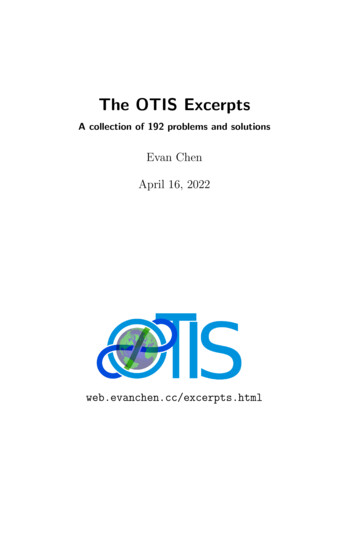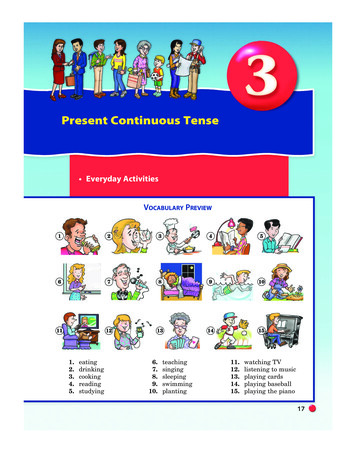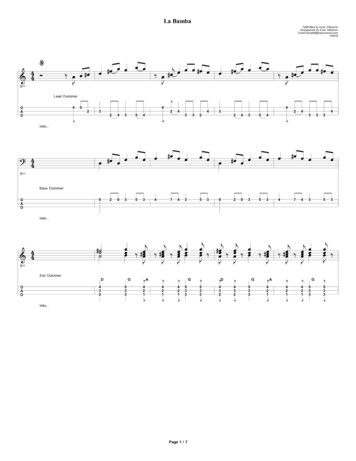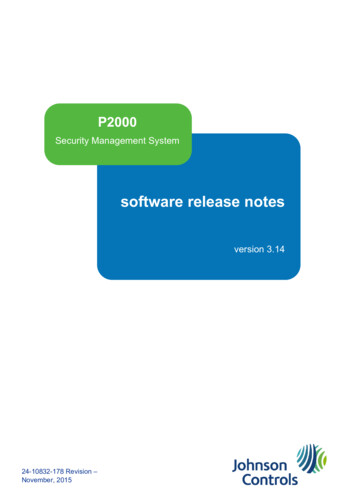
Transcription
The OTIS ExcerptsA collection of 192 problems and solutionsEvan ChenApril 16, 2022web.evanchen.cc/excerpts.html
The noblest art is that of making others happy.P. T. BarnumIf you like this book and want to support me,please consider buying me a coffee!http://ko-fi.com/evanchen/ 2019 Evan Chen. All rights reserved. Personal use only.
PrefaceThis book is a selection of notes from twelve of the lectures that I use inmy year-round math olympiad classes. The program is affectionately namedOTIS. The abbreviation officially stands for “Olympiad Training for IndividualStudy”; but in truth, I rigged the acronym so that it would match the nameof an elevator in Lincoln, Nebraska of which I had fond childhood memories.When I started teaching OTIS back in the fall of 2015, it was just a smallgroup of students at Phillips Academy that I would meet with every couple ofweeks. Despite my inexperience at the time, I have fond memories of this firstgroup, and I maybe learned as much from them as they did from me.Every year since then, the number of OTIS students has doubled, and thenumber of applications has increased even faster than that. At the same time,I became increasingly involved with volunteering with the organization of highschool contests. By the time I started graduate school, I was spending so littletime on my own studies that I began to fear (rightly or wrongly) that I mightfail out of the math PhD program.Thus, despite my best efforts, I eventually had the heartbreaking task ofhaving to tell eager and enthusiastic students that I simply did not have thetime or space to take them all under my wing. I am the kind of person whofinds it hard to say no, and so this was painful for me to do. OTIS taught methe reality that I am just one person.In this way, these notes are an apology to everyone I turned down, and toeveryone that I will have to turn down. I would have loved to be able to helpeveryone who came to my doorstep. I am sorry that I could not do more, butI wrote you a short book, as it was the least I could do.As with all my works, there are bound to be numerous errors, mistakes,or points of unclarity. Comments, suggestions, corrections are very welcome.You can reach me at evan@evanchen.cc.Evan ChenDecember 30, 2018Fremont, California, USAiii
IntroductionThe book is divided into algebra, combinatorics, and number theory. We donot cover geometry, for which Euclidean Geometry in Mathematical Olympiads[Che16] already serves the role of “comprehensive book”.The twelve main chapters in this book are structured in to four sections. A theoretical portion, of varying length, in which relevant theoremsor ideas are developed. Some of this material is new, but the majority ofit is not. Most of it has been adapted, edited, and abridged from existinghandouts that you can still find athttp://web.evanchen.cc/olympiad.html.In general, the theoretical material here tries to stick to the basics, ratherthan being comprehensive. A couple walkthroughs. These are olympiad problems which are chosento illustrate ideas, accompanied by an outline of the solution.When designing my lecture notes for OTIS, I wrote these walkthroughswith the idea of emulating a person. In a real classroom the student doesnot simply passively listen to solutions. The process is more interactive:the instructor walks a student through the example, but with a backand-forth series of prepared questions. My hope with the walkthroughsis to simulate this as best I can with static text. A series of problems. These problems cover a range of difficulties. Butin general, the first half of the problems in each chapter are intendedto be fairly accessible, perhaps at the level of IMO 1/4. The difficultyincreases quickly after that, with the closing problem usually being quitechallenging. Full solutions to both the walkthroughs and problems. (Great for inflating page count!) Readers are encouraged to read solutions even toproblems that they solved; comments, remarks, or alternate solutionsfrequently appear.In addition, at the end of each part, a handful of problems chosen from USAselection tests are given, mostly for fun.In general, I assume the reader has some minimal experience with readingand writing proofs. However, I nonetheless dedicated the first chapter to somemathematical and stylistic comments which may be helpful to beginners inproofs. Readers with significant proof experience should feel no shame inskipping this first chapter.v
April 16, 2022The OTIS Excerpts, by Evan ChenContest abbreviationsMany problems have a source quoted, but there are a large number of abbreviations as a result. We tabulate some of the abbreviations here.AIME American Invitational Math Exam, the qualifying exam for the USAnational olympiad.EGMO European Girl’s Math Olympiad (not to be confused with [Che16])ELMO The ELMO is a contest held at the USA olympiad training camp everyyear, written by returning students for newcomers.The meaning of the acronym changes each year. It originally meant“Experimental Lincoln Math Olympiad” but future names have included“elog Math Olympiad”, “End Letter Missing”, “Ex-Lincoln Math Olympiad”,‘English Language Master’s Open”. “Ego Loss May Occur”, “vErybadLy naMed cOntest”, “Eyyy LMaO”.ELMO Shortlist A list of problems from which each year’s ELMO is chosen.HMMT Harvard-MIT Math Tournament, the largest collegiate math competition in the United States. The contest is held twice a year, in Novemberand February.IMO International Math Olympiad, the supreme high-school mathematicsolympiad.IMO Shortlist A list of about 30 problems prepared annually, from which thesix problems of the IMO are selected by vote.Putnam The William Lowell Putnam Mathematical Competition, an annualcompetition for undergraduate students studying in USA and Canada.RMM Romanian Masters in Mathematics, an annual olympiad held in Romania in late February for teams with a strong performance at the International Mathematical Olympiad.TSTST The embarrassingly named “Team Selection Test Selection Test”.Held in June each year, the TSTST selects students for the USA TeamSelection Test.TST Abbreviation for Team Selection Test. Most countries use a TST asthe final step in the selection of their team for the International MathOlympiad.USAJMO USA Junior Math Olympiad, the junior version of the nationalmath olympiad for the United States (for students in 10th grade andbelow).USAMO USA Math Olympiad, the national math olympiad for the UnitedStates.vi
ContentsPrefaceiiiIntroductionv1 Notes on Proofs1.1 Common proof mistakes . . . . . . . . . . . . . . . . . . . .1.1.1 “Find all” problem are always two-part problems . .1.1.2 Checking for reversibility . . . . . . . . . . . . . . .1.1.3 Optimization problems are always two-part problems1.1.4 Be neat, be careful . . . . . . . . . . . . . . . . . . .1.2 Stylistic writing suggestions . . . . . . . . . . . . . . . . . .1.2.1 Deciding on the level of detail . . . . . . . . . . . . .1.2.2 Never write wrong math . . . . . . . . . . . . . . . .1.2.3 Emphasize the point where you cross the ocean . . .1.2.4 Leave space . . . . . . . . . . . . . . . . . . . . . . .1.3 Problems . . . . . . . . . . . . . . . . . . . . . . . . . . . .1.4 Solutions . . . . . . . . . . . . . . . . . . . . . . . . . . . .I.Algebra2 Fundamentals of Inequalities2.1 Brief warning for beginners . . . . . .2.1.1 On flipped inequalities . . . . .2.1.2 Writing chains of inequalities .2.2 Polynomial inequalities . . . . . . . . .2.2.1 AM-GM and Muirhead . . . .2.2.2 Some vague cheerleading . . . .2.2.3 Muirhead’s inequality . . . . .2.2.4 Non-homogeneous inequalities .2.3 Three polynomial tricks . . . . . . . .2.3.1 The special case of product 1 .2.3.2 Ravi substitution . . . . . . . .2.3.3 Schur’s inequality . . . . . . . .2.4 Eliminating radicals and fractions . . .2.4.1 Weighted Power Mean . . . . .2.4.2 Cauchy and Hölder . . . . . . .2.5 Inequalities in arbitrary functions . . .2.5.1 Jensen and Karamata . . . . .2.5.2 Tangent line trick . . . . . . .2.6 Walkthroughs . . . . . . . . . . . . . 242425272728281
April 16, 20222.72.8The OTIS Excerpts, by Evan ChenProblems . . . . . . . . . . . . . . . . . . . . . . . . . . . . . .Solutions . . . . . . . . . . . . . . . . . . . . . . . . . . . . . .30323 Functional Equations3.1 Definitions . . . . . . . . . . . . . . . . . . .3.1.1 On the generality of functions . . . .3.1.2 Special types of functions . . . . . .3.2 First example . . . . . . . . . . . . . . . . .3.3 Second example (or non-example) . . . . . .3.4 Four techniques for motivating substitutions3.4.1 Forced cancellation . . . . . . . . . .3.4.2 The fff trick . . . . . . . . . . . . . .3.4.3 Symmetry . . . . . . . . . . . . . . .3.4.4 Isolated parts . . . . . . . . . . . . .3.5 Cauchy’s equation . . . . . . . . . . . . . .3.5.1 Cauchy’s equation over Q . . . . . .3.5.2 Cauchy’s equation over R . . . . . .3.6 Walkthroughs . . . . . . . . . . . . . . . . .3.7 Problems . . . . . . . . . . . . . . . . . . .3.8 Solutions . . . . . . . . . . . . . . . . . . .39393940404244444546464747495052544 Monstrous Functional Equations4.1 Introduction . . . . . . . . .4.2 Clues . . . . . . . . . . . . .4.3 Linear algebra terminology4.4 Cauchy’s equation over R .4.4.1 Back to earth . . . .4.5 Walkthroughs . . . . . . . .4.6 Problems . . . . . . . . . .4.7 Solutions . . . . . . . . . .6363636466686870725 Selected Algebra from USA TST5.1 Problems . . . . . . . . . . . . . . . . . . . . . . . . . . . . . .5.2 Solutions . . . . . . . . . . . . . . . . . . . . . . . . . . . . . .818184II Combinatorics956 Graph Theory Terminology6.1 Textbook references . . . .6.2 Graphs . . . . . . . . . . . .6.3 Degree . . . . . . . . . . . .6.4 Paths, cycles, connectedness2.9797989899
ContentsApril 16, 20227 Global7.1 A simple example, the handshake lemma7.2 Expected value . . . . . . . . . . . . . .7.2.1 Definitions and notation . . . . .7.2.2 Another motivating example . .7.2.3 Linearity of expectation . . . . .7.3 The so-called pigeonhole principle . . . .7.4 Walkthroughs . . . . . . . . . . . . . . .7.5 Problems . . . . . . . . . . . . . . . . .7.6 Solutions . . . . . . . . . . . . . . . . .1011011011011021041051051071108 Local8.1 Synopsis . . .8.2 Walkthroughs8.3 Problems . .8.4 Solutions . .1191191191211249 Rigid9.1 Synopsis . . .9.2 Walkthroughs9.3 Problems . .9.4 Solutions . .13713713713914210 Free10.110.210.310.4.151151151153156Synopsis . . .WalkthroughsProblems . .Solutions . .11 Anti-Problems16511.1 Walkthroughs . . . . . . . . . . . . . . . . . . . . . . . . . . . . 16511.2 Problems . . . . . . . . . . . . . . . . . . . . . . . . . . . . . . 16611.3 Solutions . . . . . . . . . . . . . . . . . . . . . . . . . . . . . . 16812 Selected Combinatorics from USA TST17312.1 Problems . . . . . . . . . . . . . . . . . . . . . . . . . . . . . . 17312.2 Solutions . . . . . . . . . . . . . . . . . . . . . . . . . . . . . . 176III Number Theory18713 Orders13.1 Definition and examples of order . . . . . . . . . . . . . . . . .13.2 Application: Fermat’s Christmas theorem . . . . . . . . . . . .13.3 Primitive roots . . . . . . . . . . . . . . . . . . . . . . . . . . .1891891901903
April 16, 2022The OTIS Excerpts, by Evan Chen13.4 Walkthroughs . . . . . . . . . . . . . . . . . . . . . . . . . . . . 19113.5 Problems . . . . . . . . . . . . . . . . . . . . . . . . . . . . . . 19313.6 Solutions . . . . . . . . . . . . . . . . . . . . . . . . . . . . . . 19414 Look at the exponent14.1 Definition . . . .14.2 Exponent lifting14.3 Walkthroughs . .14.4 Problems . . . .14.5 Solutions . . . .20120120120220420615 Advanced techniques15.1 Pell equations . . . . . . . . . . . . . . .15.2 Jacobi symbol and quadratic reciprocity15.3 Vieta jumping . . . . . . . . . . . . . . .15.4 Walkthroughs . . . . . . . . . . . . . . .15.5 Problems . . . . . . . . . . . . . . . . .15.6 Solutions . . . . . . . . . . . . . . . . .21321321421521521621816 Constructions in Number16.1 Synopsis . . . . . . .16.2 Walkthroughs . . . .16.3 Problems . . . . . .16.4 Solutions . . . . . .225225225226228.Theory. . . . . . . . . . . . . . . . .17 Selected Number Theory from USA TST23717.1 Problems . . . . . . . . . . . . . . . . . . . . . . . . . . . . . . 23717.2 Solutions . . . . . . . . . . . . . . . . . . . . . . . . . . . . . . 238Acknowledgements4257
1Notes on ProofsThis is a chapter detailing common logic mistakes in proofs, as well ascontaining some suggestions for how to present proofs more readably. It canbe safely skipped by veterans with past proof experience. There are a smallnumber of problems at the end to try to give you practice with these types ofissues.§1.1 Common proof mistakes§1.1.1 “Find all” problem are always two-part problemsAny problem of the form “find all. . . ” is always implicitly a two-partproblem. (This includes functional equations and Diophantine equations, forexample.)To be more explicit, if you have are asked to find all x satisfying propertyP (x), and you think the answer is a set S, then you must prove thatP (x)if and only ifx S.Note that this is an “if and only if”, so there are two directions, not just one!For any solution of this form, I strongly recommend that you structure yoursolution as follows: Start by writing “We claim the answer is . . . ” and state your conjectured answer. Then, say “We prove these satisfy the conditions”, and do so. Forexample, in a functional equation with answer f (x) x2 , you shouldplug this f back in and verify the equation is satisfied. Even if thisverification is trivial, you must still explicitly include it, because it ispart of the problem. Finally, say “Now we prove these are the only ones” and do so.This is a common mistake because many standard high school curriculumsdo not make this distinction explicitly, if at all. Thus your instincts might bewrong, and so you will need to adjust slightly.To give an example of what I mean, here’s an example from middle school.Example 1. Find all real numbers x such that 3x 2 17.5
April 16, 2022The OTIS Excerpts, by Evan ChenBogus Solution. Note that3x 2 17 3x 15 x 5.Hence the answer is x 5.But really what you have shown is that 3x 2 17 x 5. You haven’tproven the other direction. Fortunately, in this case it’s very easy to reverseall the steps you did; x 5 3x 15 3x 2 17. Put another way,here is a correct solution.Solution 1. Note that3x 2 17 3x 15 x 5.Therefore the answer is x 5. No big deal, right? However it’s not always true that you can simply replace with .Example 2. Find all real numbers x such that x 7 x 1.This time, we see something different. Consider the solution:Bogus Solution. Note that x 7 x 1 x 7 x2 2x 1 0 x2 x 6. x 3, 2.Hence x 3 or x 2.This time, the first arrow (when we square both sides) is not reversible. Wehave proven that x 7 x 1 x 3, 2 but this time the converse isfalse, since x 3 does not work.If you follow my advice to structure your solutions by stating the answer,checking it, and then proving it is the only ones, you won’t make this mistake. Solution 2. The answer is x 2. Since 2 7 3 2 1, it works.6
1 Notes on ProofsApril 16, 2022We now show this is the only solution. Note that x 7 x 1 x 7 x2 2x 1 0 x2 x 6. x 3, 2.Hence x 3 or x 2. However, we can see that x 3 does not work,since 3 7 2 ̸ 2 ( 3) 1. Therefore x 2 is the only solution, asclaimed. Now, here is a more serious example.Example 3 (USAJMO 2011). Find all positive integers n such that 2n 12n 2011n is a perfect square.Solution 3. The answer is n 1 only.This clearly works, since 21 121 20111 2025 452 .Now we verify this is the only solution. If n is odd and n 1, then takingmodulo 4 we see the 2n 12n 2011n 3 (mod 4), so it is not a square. If nis even, then taking modulo 3 we see the 2n 12n 2011n 2 (mod 3), so itis not a square. Thus n 1 is the only solution. The subtle mistake one can make is to forget to do the calculation 21 121 20111 2025 452 . To see why this is necessary, compare this with ahypothetical different problem.Example 4. Find all positive integers n such that 2n 12n 2023n is a perfectsquare.Solution 4. There are no such n at all.First, n 1 does not work since 21 121 20231 2037, which is not asquare.If n is odd and n 1, then taking modulo 4 we see the 2n 12n 2023n 3(mod 4), so it is not a square. If n is even, then taking modulo 3 we see the2n 12n 2023n 2 (mod 3), so it is not a square. §1.1.2 Checking for reversibilityAs you can see the previous logical mistake is due to not distinguishing betweenP Q and Q P . Many of you have been taught the wrong instincts,and now you have to adjust. For “find all” problems the surest way to do thisis to just do both directions explicitly in the way I suggested.But this won’t cover everything. I’m thinking in particular of the specialcase Q true. Consider the following example.7
April 16, 2022The OTIS Excerpts, by Evan ChenExample 5. Suppose θ and η are angles in the interval (0, 12 π). Verify thetrig identity θ ηsin η sin θtan .2cos η cos θThe “high-school” proof again messes up the direction of the arrows.Bogus Solution. Write θ ηsin η sin θtan 2cos η cos θsin(θ η)sin η sin θ 1 cos(θ η)cos η cos θsin η sin θsin θ cos η cos θ sin η 1 cos θ cos η sin θ sin ηcos η cos θ sin θ cos2 η sin2 η sin η cos2 θ sin2 θ sin θ sin η sin θ sin η sin θ sin η.(†) The second line is by tangent half-angle formula.What you’ve shown is the (†) true. This isn’t worth anything. I have amuch easier proof that (†) true: just multiply both sides by zero.What you really want is true (†), which you can again do by beingcareful that all arrows above are and not . (The condition aboutthe angles ensures that we do not have division by zero issues.)§1.1.3 Optimization problems are always two-part problemsAlong the same lines, some problems will ask you to “find the minimum (ormaximum) value of X”. These problems are always two parts as well,you need to prove a bound on X, and then show that bound can actually beachieved.In such situations, I strongly recommend you write your solution as follows: Start by writing “We claim the minimum/maximum is . . . ”. Then, say “We prove that this is attainable”, and give the construction (or otherwise prove existence). Even if this verification is trivial, youmust still explicitly include it, because it is part of the problem. Finally, say “We prove this is a lower/upper bound”, and do so.Here is a fun example.Example 6 (USAMO 2010). The 2010 positive real numbers a1 , a2 , . . . , a2010satisfy the inequality ai aj i j for all 1 i j 2010. Determine, withproof, the largest possible value of the product a1 a2 . . . a2010 .8
1 Notes on ProofsApril 16, 2022This problem is quite difficult, and will be covered in a walkthrough later.For now, we show you how to not solve the problem by presenting three bogussolutions which get pairwise distinct answers!Bogus Solution. We have a1 a2010 2011, a2 a2009 2011, . . . , a1005 a1006 2011, so a1 a2 . . . a2010 20111005 . Bogus Solution. Multiplying all the possible 2010inequalities together2gives1 20092010YYan i j .n 11 i j 2010Bogus Solution. We have a1 a2 3, a3 a4 7, and so on, thusa1 a2 . . . a2010 3 · 7 · · · · · 4019.Moreover, one can prove that this is the lowest possible bound of the form(i1 j1 )(i2 j2 ) . . . (i1005 j1005 ), where i1 , . . . , j1005 are a permutationof 1, . . . , 2010. Thus this is the answer.QAll of these solutions have correctly proven an upper bound onai , butnone of them have made any progress on showing that there actually existsai achieving that constant, which turns out to be the true difficulty of theproblem.§1.1.4 Be neat, be carefulThis list isn’t exhaustive. These are just the most common mistakes that moreexperienced students have learned to avoid. Yet there are plenty of problemsthat have their own pitfalls.The best thing you can do about this is to be neat and be careful. If a solution has cases, give each case a separate bullet point and labelclearly exactly what case it is doing. Write out more details on parts that you feel less confident in. If you have central claims in the problem, write them in full as explicitlemmas in the problem.In short, be organized.9
April 16, 2022The OTIS Excerpts, by Evan Chen§1.2 Stylistic writing suggestions§1.2.1 Deciding on the level of detailOne of the most common questions I get is: “how much detail do I needto include on a contest?”. The answer is actually quite simple: enough toconvince the grader you know the solution.1 To put it one way, wheneveryou omit a detail, the grader has to decide whether you know how to do itand just did not write it, or whether you don’t know how to do it and are justbluffing. So if you are ever unsure about how much to write, just ask yourselfthat.In still other words, you should write your solution in such a way that astudent who did not solve the problem could not plausibly write the samething you did. This is especially important if you have a long computationalsolution, for example solving geometry with complex numbers. You cannotjust skip over a page of calculation by saying that “simplifying, we find this isequal to . . . ”, because a student who did not solve the problem (i.e. was notactually able to do the calculation) is perfectly capable of writing the samething.§1.2.2 Never write wrong mathThis is much more of a math issue than a style issue: you can lose all of yourpoints for making false claims, because this is the easiest way to convince thegrader that your solution is wrong.As a special case, don’t say something that is partially true and then sayhow to fix it later. At best this will annoy the grader; at worst they may getconfused and think the solution is wrong.§1.2.3 Emphasize the point where you cross the oceanSolutions to olympiad problems often involve a few key ideas, with the restof the solution being checking details. You want graders to immediately seeall the key ideas in the solution: this way, they quickly have a high-levelunderstanding of your approach.Let me share a quote from Scott Aaronson:Suppose your friend in Boston blindfolded you, drove you aroundfor twenty minutes, then took the blindfold off and claimed youwere now in Beijing. Yes, you do see Chinese signs and pagodaroofs, and no, you can’t immediately disprove him — but basedon your knowledge of both cars and geography, isn’t it more likely1 Thisis a slightly different standard than in many other places. For example, considerthe official solutions to a contest. Here the reader knows the author already has thesolution, and the reader is just trying to understand it. Whereas during a contest, thegrader already knows the solution, and is interested in whether you know it.10
1 Notes on ProofsApril 16, 2022you’re just in Chinatown? . . . We start in Boston, we end upin Beijing, and at no point is anything resembling an oceanever crossed.Olympiad solutions work the same way: a geometry solution might require astudent to do some angle chasing, deduce that two triangles are congruent,and then finish by doing a little more angle chasing. In that case, you want tohighlight the key step of proving the two triangles were congruent, so the gradersees it immediately and can say “okay, this student is using this approach”.Ways that you can highlight this are: Isolating crucial steps and claims as their own lemmas.2 Using claims to say what you’re doing. Rather than doing angle chasing and writing “blah blah blah, therefore MB IB M MC IC M ”,consider instead “We claim MB IB M MC IC M , proof”. Displaying important equations. For example, notice how the line MB IB M MC IC M(1.1)jumps out at the reader. You can even number such claims to reference them later, e.g. “by (1.1)”. This is especially useful in functionalequations. Just say it! Little hints like “the crucial claim is X” or “the main ideais Y ” are immensely helpful. Don’t make X and Y look like anotherintermediate step.§1.2.4 Leave spaceMost people don’t leave enough space. This makes solutions hard to read.Things you can do to help with this: Skip a line after paragraphs. Use paragraph breaks more often than youalready do. If you isolate a specific lemma or claim in your proof, then it shouldbe on its own line, with some whitespace before and after it. Any time you do casework, you should always split cases into separateparagraphs or bullet points. Make it visually clear when each case beginsand ends.2 Thisis often useful for another reason: breaking the proof into individual steps. Thecomplexity of understanding a proof grows super-linearly in its length; therefore breakingit into smaller chunks is often a good thing.11
April 16, 2022The OTIS Excerpts, by Evan Chen Display important equations, rather than squeezing them into paragraphs. If you have a long calculation, then do an aligned display3rather than squeezing it into a paragraph. For example, instead of writing 0 (a b)2 (a b)2 4ab (10 c)2 4 (25 c(a b)) (10 c)2 4 (25 c(10 c)) c(20 3c), write instead0 (a b)2 (a b)2 4ab (10 c)2 4 (25 c(a b)) (10 c)2 4 (25 c(10 c)) c(20 3c).§1.3 ProblemsProblem 7. Determine, with proof, the smallest positive integer c such thatfor any positive integer n, the decimal representation of the number cn 2014has digits all less than 5.Problem 8. The numbers 1, 2, . . . , 10 are written on a board. Every minute,one can select three numbers a, b, c on the board, erase them, and write a2 b2 c2 in their place. This process continues until no more numberscan be erased. What is the largest possible number that can remain on theboard at this point?Problem 9 (Putnam 2017). Find the smallest set S of positive integers suchthat(a) 2 S,(b) n S whenever n2 S,(c) (n 5)2 S whenever n S.(The set S is “smallest” in the sense that S is contained in any other suchset.)Problem 10 (USAMO 2015). Steve is piling m 1 indistinguishable stoneson the squares of an n n grid. Each square can have an arbitrarily highpile of stones. After he finished piling his stones in some manner, he canthen perform stone moves, defined as follows. Consider any four grid squares,which are corners of a rectangle, i.e. in positions (i, k), (i, l), (j, k), (j, l) forsome 1 i, j, k, l n, such that i j and k l. A stone move consists ofeither removing one stone from each of (i, k) and (j, l) and moving them to(i, l) and (j, k) respectively, or removing one stone from each of (i, l) and (j, k)and moving them to (i, k) and (j, l) respectively.3 This12is the align* environment, for those of you that like LATEX.
1 Notes on ProofsApril 16, 2022Two ways of piling the stones are equivalent if they can be obtained fromone another by a sequence of stone moves. How many different non-equivalentways can Steve pile the stones on the grid?13
April 16, 2022The OTIS Excerpts, by Evan Chen§1.4 SolutionsSolution 7. The answer is c 10. In what follows we say that a number isgood if all its decimal digits are less than 5.We first prove c 10 is a working example for all n. When n 1, 2, 3, wehave 2024, 2114 and 3014, which are all good. When n 4, we find that10n 2014 1 000. . 000} 2014 .{zn 4 zeroswhich is good. This shows that c 10 is works.Next, we show that c 10 is necessary. For c 1, 2, 3, 4, 5, taking n 1 gives the numbers 2015, 2016, . . . , 2019,none of which are good. On the other hand, for c 6, 7, 8, 9, taking n 2 gives the numbers2050, 2063, 2078, 2095, none of which are good. Solution 8. The answer is 384 8 6.We begin by observing that the sum of the squares of all numbers on theboard is preserved. Moreover, there are initially 10 numbers, and we erase 2at a time, so at the end of the process there will be exactly two numbers, callthem a and b. By our observation, these numbers are supposed to satisfya2 b2 12 22 · · · 102 385.( ) We now claim that 384 is achievable. Indeed, suppose we always avoiderasing the number 1 that was initially on the board. Then at the end of theprocess, one of the numbers on the board is a 1; thus the other one is 384by ( ).On the other hand, observe that since
national olympiad. EGMO European Girl’s Math Olympiad (not to be confused with [Che16]) ELMO The ELMO is a contest held at the USA olympiad training camp every year, written by returning students for newcomers. The meaning of the acronym changes each year. It originally meant “Experimental Lincoln










